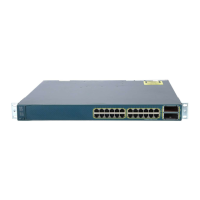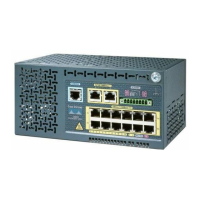34-3
Catalyst 3750 Switch Software Configuration Guide
78-16180-02
Chapter 34 Configuring IP Unicast Routing
Understanding IP Routing
Dynamic routing protocols are used by routers to dynamically calculate the best route for forwarding
traffic. There are two types of dynamic routing protocols:
• Routers using distance-vector protocols maintain routing tables with distance values of networked
resources, and periodically pass these tables to their neighbors. Distance-vector protocols use one
or a series of metrics for calculating the best routes. These protocols are easy to configure and use.
• Routers using link-state protocols maintain a complex database of network topology, based on the
exchange of link-state advertisements (LSAs) between routers. LSAs are triggered by an event in
the network, which speeds up the convergence time or time required to respond to these changes.
Link-state protocols respond quickly to topology changes, but require greater bandwidth and more
resources than distance-vector protocols.
Distance-vector protocols supported by the Catalyst 3750 switch are Routing Information Protocol
(RIP), which uses a single distance metric (cost) to determine the best path and Border Gateway Protocol
(BGP), which adds a path vector mechanism. The switch also supports the Open Shortest Path First
(OSPF) link-state protocol and Enhanced IGRP (EIGRP), which adds some link-state routing features
to traditional Interior Gateway Routing Protocol (IGRP) to improve efficiency.
Note On a switch stack, the supported protocols are determined by the software running on the stack master.
If the stack master is running the SMI, only default routing, static routing and RIP are supported. All
other routing protocols require the EMI.
IP Routing and Switch Stacks
A Catalyst 3750 switch stack appears to the network as a single router, regardless of which switch in the
stack is connected to a routing peer. For additional information about switch stack operation, see
Chapter 5, “Managing Switch Stacks.”
The stack master performs these functions:
• It initializes and configures the routing protocols.
• It sends routing protocol messages and updates to other routers.
• It processes routing protocol messages and updates received from peer routers.
• It generates, maintains, and distributes the distributed Cisco Express Forwarding (dCEF) database
to all stack members. The routes are programmed on all switches in the stack bases on this database.
• The MAC address of the stack master is used as the router MAC address for the whole stack, and all
outside devices use this address to send IP packets to the stack.
• All IP packets that require software forwarding or processing go through the CPU of the stack
master.
Stack members perform these functions:
• They act as routing standby switches, ready to take over in case they are elected as the new stack
master if the stack master fails.
• They program the routes into hardware. The routes programmed by the stack members are the same
that are downloaded by the stack master as part of the dCEF database.
If a stack master fails, the stack detects that the stack master is down and elects one of the stack members
to be the new stack master. During this period, except for a momentary interruption, the hardware
continues to forward packets with no protocols active.
